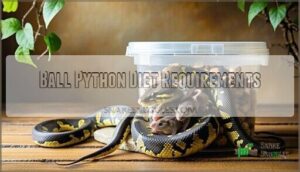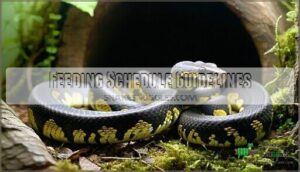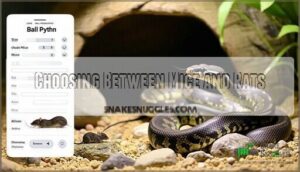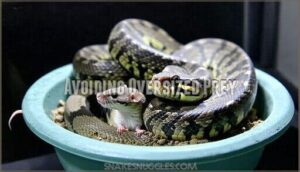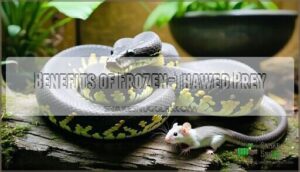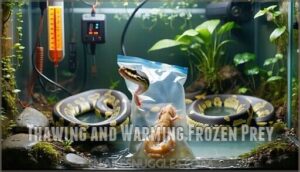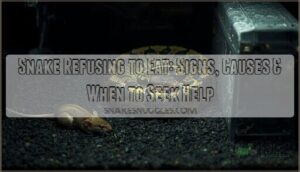This site is supported by our readers. We may earn a commission, at no cost to you, if you purchase through links.
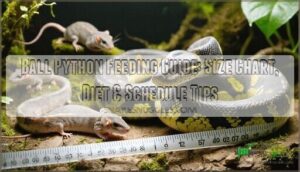
Young pythons typically eat adult mice, while full-grown adults need small to medium rats. You’ll feed juveniles every 5-7 days, adults every 2-3 weeks.
Watch for that telltale bulge after feeding—it should be noticeable but not extreme. Getting the size wrong can cause regurgitation or health issues, so when in doubt, go slightly smaller rather than larger.
The right feeding approach involves more than just size considerations though. It’s about finding a balance that ensures your snake’s health and well-being, avoiding issues like health issues.
Table Of Contents
- Key Takeaways
- Ball Python Feeding Basics
- Ball Python Diet Requirements
- Feeding Schedule Guidelines
- Prey Size and Selection
- Feeding Live Vs Frozen Food
- Ball Python Nutritional Needs
- Feeding Techniques and Safety
- Advanced Feeding Considerations
- Frequently Asked Questions (FAQs)
- Do ball pythons need a feeding chart?
- How big should a ball python eat?
- What to feed a ball python?
- How often should you feed a ball python?
- What factors influence a ball python feeding schedule?
- Can a ball python eat more than one meal?
- What size should I feed my ball python?
- How often should I feed a ball python in a day?
- How do I know if I’m feeding my ball python enough?
- Can ball pythons eat insects or worms?
- Conclusion
Key Takeaways
- Match prey width to your snake’s thickest body section – choose rodents that are 1 to 1.25 times your python’s midsection diameter to prevent choking or regurgitation
- Feed based on age, not appetite – hatchlings need meals every 5-7 days, juveniles weekly, and adults every 2-3 weeks to support proper growth without overfeeding
- Choose frozen-thawed over live prey – you’ll eliminate injury risks from bites and scratches while making storage more convenient and cost-effective
- Go smaller when uncertain – undersized prey won’t harm your python, but oversized meals can cause serious digestive issues and health complications
Ball Python Feeding Basics
Feeding your ball python properly starts with understanding three key factors: how often to feed, what size prey to offer, and the safest feeding techniques.
Getting these basics right guarantees your snake stays healthy while avoiding common feeding mistakes that can stress or harm your pet, which is crucial for proper care.
Feeding Frequency Guidelines
Your ball python’s feeding schedule depends entirely on their age and growth stage.
Hatchlings need meals every 5-7 days to fuel rapid development, while juveniles eat weekly.
As your snake matures, stretch intervals to every 10-14 days for sub-adults and 2-3 weeks for adults.
This progression supports healthy growth rates without causing obesity-related health issues.
Prey Size Selection
Getting the right prey size is like finding the perfect fit – too small won’t satisfy your python, too large could cause serious problems.
Your ball python feeding size guide starts with measuring your snake’s thickest point, typically the midsection.
Here’s your prey measurement checklist:
- Food ratio: Prey should be 1 to 1.25 times your snake’s girth
- Snake girth: Measure the widest part of your python’s body
- Prey limits: Never exceed 1.5 times the snake’s diameter
- Feeding charts: Use visual guides to match prey size to snake weight
- Python feeding size: Adjust portions as your snake grows
When switching between prey types, maintain these ratios consistently.
Feeding Techniques and Tips
Proper prey presentation matters more than you’d think.
Use feeding tongs to safely offer food, warming frozen prey to 100-105°F before presenting it.
Watch your snake’s behavior during meals—they’ll tell you everything.
Always wash hands afterward and avoid handling for 48 hours post-feeding to prevent regurgitation and stress.
Ball Python Diet Requirements
Your ball python’s diet is simpler than you might think – these snakes are obligate carnivores that thrive on whole rodents like mice and rats.
Understanding their specific nutritional needs guarantees your python stays healthy and grows properly throughout its life, which is crucial for the snake’s overall well-being and can be considered a key aspect of being an obligate carnivore.
Primary Food Sources
Your ball python’s diet centers around three main rodent options that’ll keep your snake healthy and satisfied. Domestic rats and mice form the backbone of ball python feeding, whether you’re meal planning for a juvenile or adult python. These prey items meet all nutrient needs naturally.
**Three simple prey options—rats, mice, and occasional birds—deliver everything your ball python needs for lifelong health.
Here are your primary food sources for effective ball python diet management:
- Mice – Perfect starter prey for young pythons, with sizes ranging from pinkies to adult mice depending on your snake’s growth stage
- Rats – The gold standard for mature ball pythons, offering better nutrition-to-size ratios than mice as your python grows
- Occasional birds – Quail chicks or domestic chicks can add variety, though not all pythons accept avian prey readily
Most keepers stick with frozen-thawed rodents since they’re safer than live prey and easier to store. Your python snake care routine becomes much simpler when you establish consistent prey preferences early on. Understanding optimal feeding techniques is essential for a healthy ball python diet.
Nutritional Needs and Supplements
Whole-prey nutrition delivers complete vitamin needs and mineral supplements naturally, eliminating most dietary additives.
However, calcium deficiency can occur without UVB lighting, requiring occasional dusting. Your carnivorous diet approach maintains nutrition balance through proper prey size selection rather than complex supplementation.
Understanding the proper feeding schedule is essential for a ball python’s health and growth.
| Supplement Type | When Needed |
|---|---|
| Calcium powder | UVB deficiency cases |
| Vitamin D3 | Limited natural lighting |
| Multivitamin dust | Occasional use only |
| None required | Proper whole-prey diet |
Avoiding Inappropriate Foods
In the context of ball python feeding, you’ll want to steer clear of toxic foods that can harm your snake.
Dead animals found outside, amphibians, fish, and insects aren’t part of a proper ball python diet and can introduce parasites or nutritional imbalances.
- Toxic Foods: Never feed chocolate, onions, garlic, or any human food – these can poison your python
- Bad Prey: Avoid wild-caught rodents, which carry parasites and diseases that threaten your snake’s health
- Food Allergies: While rare, some pythons reject certain prey colors or scents – stick to standard mice and rats
- Unsafe Supplements: Don’t add random vitamins or minerals without veterinary guidance – whole prey provides complete nutrition
- Dead Animals: Skip roadkill or outdoor carrion – only use commercially bred, frozen-thawed rodents for safety
Feeding Schedule Guidelines
You’ll need to match your ball python’s feeding schedule to its age, weight, and life stage, since a growing hatchling eats much more often than a sleepy adult.
Keeping track of these intervals can feel like managing a picky eater’s calendar, but it’s the best way to support healthy growth and prevent problems like obesity.
Age-Based Feeding Schedules
Your ball python’s age directly determines how often you’ll need to fill their food bowl.
Hatchling care requires feeding every 5 days, while juvenile feeding shifts to weekly schedules.
Subadult nutrition needs drop to every 10-14 days, and adult meals stretch to 2-3 weeks.
This python feeding chart matches natural growth rates perfectly.
Understanding the proper feeding frequency guidelines is essential for the snake’s health and development.
You can find more information on this topic at feeding frequency guidelines, which provides a comprehensive guide to feeding your ball python.
Weight-Based Feeding Adjustments
Adjusting your ball python’s feeding schedule based on weight guarantees proper growth rates and nutrition balance.
Weight monitoring helps you fine-tune meal sizing for healthy development.
- Hatchlings (up to 100g): Feed every 4-7 days with appropriately sized prey
- Juveniles (100-500g): Every 7-14 days as growth rate naturally slows
- Subadults (500-1000g): Every 14-21 days, reducing frequency as snake matures
- Adults (1000g+): Every 3-6 weeks reflecting slower metabolism and activity
- Monitor body condition: Adjust your ball python feeding schedule based on visible weight changes
Use feeding charts as guidelines, but your snake’s individual weight determines the best ball python feeding tips for ideal development.
Breeding and Gravid Female Feeding
During breeding season, you’ll need to adjust your ball python feeding schedule based on reproductive status.
Breeding males often refuse food for extended periods during mating, so don’t panic if they skip meals for weeks.
Gravid females require increased feeding frequency before egg-laying to support maternal diet and reproductive health, then resume normal python feeding chart guidelines post-laying.
Prey Size and Selection
Selecting the right prey size is essential for your ball python’s health and safety.
You’ll need to measure carefully and choose between mice and rats based on your snake’s age and size, considering complete concepts such as the snake’s growth stage and dietary needs.
Measuring Prey Size Correctly
Accurate prey measurement prevents overfeeding injuries and guarantees proper digestion.
Getting prey size right is like finding the perfect puzzle piece for your python’s health.
You’ll measure your snake’s thickest body section, then select prey matching these feeding ratios.
Using the right ball python feeders is vital for a successful feeding schedule, which involves understanding proper feeder selection.
Key Prey Measurement Steps:
- Measure snake girth at the widest midsection point using flexible measuring tape
- Calculate prey diameter – should equal 1 to 1.25 times your python’s width
- Check prey thickness – never exceed your snake’s natural jaw expansion limits
- Ignore weight labels – focus on prey diameter measurements for accuracy
- Create feeding chart – document successful feeder sizes for consistent prey selection
Choosing Between Mice and Rats
You’ll face a classic debate when feeding ball pythons: mice versus rats. Both prey options work well, but rats offer superior nutrition and faster growth rates.
Mouse sizes work great for hatchlings, but switching to rats early prevents feeding issues later.
Consider prey availability in your area and your snake’s preferences when making feeding choices. Proper breeding colony management is essential for a steady supply of healthy prey.
Avoiding Oversized Prey
Oversized prey puts your ball python at serious risk.
Never feed prey larger than 1.25 times your snake’s thickest body section.
Choosing appropriately sized meals prevents choking, digestive issues, and regurgitation.
When in doubt, go smaller—your python’s digestive health depends on proper meal portioning and feeding safety practices.
Feeding Live Vs Frozen Food
When you’re deciding between live and frozen prey for your ball python, frozen-thawed options offer significant safety advantages over live feeding.
Frozen prey eliminates the risk of injury to your snake while being more convenient to store and often more cost-effective than purchasing live rodents.
Benefits of Frozen-Thawed Prey
Frozen-thawed prey offers significant advantages for ball python feeding.
You eliminate injury risks since dead rodents can’t bite or scratch your snake.
Prey safety improves dramatically with frozen benefits including parasite reduction and consistent prey quality.
The use of frozen thawed mice involves understanding proper frozen mouse storage.
| Safety Benefits | Convenience Factors | Quality Advantages |
|---|---|---|
| No bite/scratch injuries | Bulk purchasing possible | Controlled nutrition value |
| Reduced parasite transmission | Easy storage for months | Consistent prey size |
| Lower infection risk | No live animal care needed | Better thawing tips available |
| Prevents prey escape | Advance meal preparation | Reduced contamination risk |
| Veterinarian recommended | Simplified feeding process | Enhanced prey quality control |
Risks of Live Prey Feeding
Feeding live prey to your ball python creates unnecessary risks that can seriously harm your snake.
Live rodents bite, scratch, and stress your python during feeding sessions.
| Risk Category | Potential Problems |
|---|---|
| Parasite Risks | Wild parasites, internal worms |
| Injury Dangers | Bites, scratches, eye damage |
| Stress Factors | Prolonged hunting, feeding anxiety |
| Disease Transmission | Bacterial infections, viruses |
Feeding accidents happen when rodents fight back, potentially causing severe wounds.
Live prey also carries disease transmission risks that frozen options eliminate completely.
Thawing and Warming Frozen Prey
Proper thawing guarantees your ball python receives safe, appetizing frozen prey. Never microwave rodents—this creates dangerous hot spots that can burn your snake’s mouth and throat.
Understanding the benefits of frozen feeding methods is vital for snake owners to make informed decisions about their pet’s diet.
| Thawing Methods | Temperature & Time |
|---|---|
| Room Temperature | 2-4 hours for mice, 4-6 hours for rats |
| Warm Water Bath | 30-60 minutes in sealed bag |
| Refrigerator Overnight | 8-12 hours, safest method |
Always check prey temperature before feeding—it should feel slightly warm to touch (100-105°F). Cold prey often gets rejected, while overheated prey poses serious injury risks.
Ball Python Nutritional Needs
Your ball python’s health depends on more than just the right prey size and feeding schedule.
While whole rodents provide complete nutrition, you’ll need to understand specific vitamin and mineral requirements to prevent deficiencies that could impact your snake’s long-term wellbeing.
Vitamin and Mineral Requirements
Your ball python’s vitamin and calcium requirements aren’t as complicated as they seem.
Whole prey naturally provides most nutrients, but calcium needs and vitamin D levels can fall short with commercial rodents.
A balanced calcium supplement with vitamin D3 fills these gaps perfectly.
Mineral supplements and dietary additives help maintain proper nutritional balance when used sparingly—think of nutritional supplements as insurance, not daily requirements.
Preventing Nutritional Deficiencies
Nutritional deficiencies can sneak up on your ball python like a thief in the night, but you’re not powerless against them.
Whole prey provides complete nutrition, making deficiencies rare when you follow proper ball python feeding practices.
- Monitor body condition – Watch for weight loss, poor shed quality, or lethargy indicating nutritional problems
- Maintain proper prey size – Appropriately sized rodents guarantee adequate nutrient intake for healthy growth
- Watch for deficiency signs – Kinked spine, soft bones, or poor appetite signal dietary needs aren’t met
- Provide variety occasionally – Alternate between mice and rats to support diverse dietary needs
- Provide proper digestion – Ideal temperatures help your snake absorb nutrients effectively from whole prey
Calcium and Multivitamin Supplements
Supplements aren’t typically necessary since whole prey provides complete nutrition for ball python feeding.
However, you might consider occasional calcium supplement dusting if your snake lacks UVB lighting, which can lead to calcium deficiency.
A light multivitamin dusting every few feedings helps maintain nutrient balance. Focus on supplement timing—dust prey lightly before offering, ensuring proper vitamin needs without overdoing mineral supplements.
Understanding the role of calcium intake is vital for maintaining healthy snake health and preventing metabolic bone disease.
Feeding Techniques and Safety
Proper feeding techniques protect both you and your ball python from injury while ensuring successful meals.
You’ll need to master safe handling methods, recognize stress signals, and maintain clean feeding practices to keep your snake healthy and reduce the risk of regurgitation, which is crucial for successful meals.
Handling and Feeding Precautions
Always prioritize safety when handling prey and feeding your ball python to prevent injuries and reduce snake stress.
Proper prey handling and feeding safety measures protect both you and your pet from potential feeding errors that could impact digestive care.
Essential feeding safety precautions include:
- Use long feeding tongs (12+ inches) to maintain safe distance during feeding
- Wash hands thoroughly before and after handling prey items
- Allow frozen prey to thaw completely and warm to 100-105°F before offering
- Never handle your python for 48-72 hours after feeding to prevent regurgitation
Following your ball python feeding schedule consistently while implementing these safety measures guarantees successful feeding sessions and supports your python feeding needs outlined in any thorough ball python care guide.
Reducing Stress and Regurgitation
Preventing regurgitation requires careful attention to your snake’s environment and handling routine. Never move your ball python to feed – this creates unnecessary stress that can trigger vomiting. Always feed inside their enclosure and avoid handling for 48 hours after meals to allow proper digestion.
| Stress Factor | Prevention Method | Recovery Time |
|---|---|---|
| Moving to feed | Feed in enclosure | Immediate |
| Post-meal handling | Wait 48 hours | 2-3 days |
| Temperature drops | Maintain 88-92°F | 24 hours |
Temperature consistency is your best friend for digestion management. Cold environments slow metabolism and increase regurgitation risk, so maintain proper heat gradients throughout the feeding process and recovery period.
Maintaining Enclosure Hygiene
Proper cleaning schedules keep your ball python enclosure healthy and odor-free. Remove uneaten prey within twelve hours to prevent bacterial growth and maintain humidity control.
Spot-clean waste immediately, then sanitize affected areas with reptile-safe cleaners. Weekly tank sanitizing prevents harmful bacteria buildup.
Clean water bowls regularly and replace substrate as needed. These hygiene practices guarantee a pristine snake enclosure environment and facilitate temperature regulation.
Regular use of effective reptile cleaning products is vital for maintaining a healthy environment and ensuring your ball python’s well-being through proper cleaning and reptile care.
Advanced Feeding Considerations
As your ball python matures, you’ll need to fine-tune your feeding approach beyond basic schedules and prey sizes.
These advanced considerations help you navigate special situations like shedding cycles, breeding seasons, and long-term health monitoring that can substantially impact your snake’s feeding behavior and nutritional needs.
Feeding During Shedding and Breeding
During shedding, your ball python’s appetite typically disappears—skip feeding until they’ve completed their shed cycle.
Post shedding feeding can resume normally within a few days.
Breeding males often refuse meals during mating season, requiring adjusted ball python feeding schedules.
Gravid females need increased breeding nutrition before egg-laying, then careful mating feeding management throughout their reproductive cycle for ideal egg care.
Adjusting Feeding Frequency and Size
Your ball python’s feeding needs change as they grow, requiring careful adjustments to prevent health issues. Smart meal planning involves monitoring your snake’s weight and body condition regularly.
Here’s how to adjust your ball python feeding schedule effectively:
- Track weekly weights during first year for accurate feeding charts
- Reduce frequency gradually as snake growth slows after 750g
- Adjust prey size to match 10-15% of current body weight
- Monitor body condition – chunky snakes need smaller meals
- Document feeding cycles to identify patterns and optimize weight management
Overfeeding leads to obesity and shortened lifespans, while underfeeding stunts development.
Monitoring Growth and Health
Track your ball python’s development by weighing them monthly on a digital scale.
Consistent growth rates indicate proper feeding, while sudden weight changes signal potential health issues requiring adjustment.
| Age Group | Expected Growth Rate |
|---|---|
| Hatchlings (0-6 months) | 10-15g per month |
| Juveniles (6-12 months) | 15-25g per month |
| Sub-adults (1-3 years) | 25-50g per month |
| Adults (3+ years) | Minimal weight gain |
Regular snake monitoring helps you catch feeding problems early and maintain ideal ball python health through proper weight management.
Frequently Asked Questions (FAQs)
Do ball pythons need a feeding chart?
Absolutely, you’ll need a feeding chart like your life depends on it.
Charts help you track your snake’s age, weight, and proper prey size.
They prevent overfeeding and guarantee consistent schedules for peak health.
How big should a ball python eat?
Choose prey that’s 1 to 25 times your snake’s midsection diameter. You’ll see a moderate bulge after feeding that shrinks over several days. Oversized meals can cause choking or regurgitation.
What to feed a ball python?
Ridiculously picky eaters, ball pythons thrive on frozen-thawed mice or rats exclusively.
You’ll feed juveniles mice, then switch to rats around 200-300 grams.
Avoid wild-caught prey—stick to commercially-bred rodents for superior health and safety.
How often should you feed a ball python?
Feed your ball python every 5-7 days as a hatchling, every 7-14 days as a juvenile, and every 2-3 weeks as an adult.
Adjust frequency based on age and size for ideal health.
What factors influence a ball python feeding schedule?
Your snake’s age holds the key—younger pythons need frequent meals for rapid growth, while adults thrive on less. Temperature, size, breeding status, and shedding cycles all determine timing.
Can a ball python eat more than one meal?
Yes, adult ball pythons typically eat 1-2 prey items per feeding session.
You can offer multiple appropriately-sized rodents during one meal, but don’t exceed their stomach capacity or cause overfeeding issues.
What size should I feed my ball python?
Think your python’s a bottomless pit? You’re not alone! Feed prey that’s 1 to 25 times your snake’s thickest body diameter. Too big risks injury; too small won’t satisfy them properly.
How often should I feed a ball python in a day?
Ball pythons don’t eat daily—they’re fed only once every 5-21 days depending on age.
Hatchlings eat every 5-7 days, juveniles every 7-14 days, and adults every 2-3 weeks.
Never feed daily.
How do I know if I’m feeding my ball python enough?
Surprisingly, 80% of ball python health issues stem from improper feeding.
You’ll know you’re feeding correctly when your snake maintains steady weight gain (juveniles) or stable weight (adults), shows a visible but moderate bulge after eating that disappears within days, has regular bowel movements, and displays normal activity levels between meals.
Can ball pythons eat insects or worms?
No, ball pythons shouldn’t eat insects or worms.
They’re obligate carnivores requiring whole prey like mice or rats for proper nutrition.
Insects lack essential nutrients and won’t sustain your python’s health long-term.
Conclusion
Mastering your ball python feeding guide size isn’t rocket science, but it’s the foundation of proper snake care.
You’ve learned that prey width should match your python’s thickest section, with juveniles eating every 5-7 days and adults every 2-3 weeks.
Remember to choose frozen-thawed prey when possible, monitor for appropriate post-feeding bulges, and adjust portions based on your snake’s age and weight.
When you’re uncertain about sizing, err on the smaller side to prevent regurgitation and health complications.
- https://community.morphmarket.com/t/prey-size-and-feed-frequency/43726
- https://www.youtube.com/watch?v=Ci_9e9GS-sE
- https://resources.pangovet.com/pet-nutrition/snakes/ball-python-feeding-chart/
- https://www.reddit.com/r/ballpython/comments/z65x3n/ball_python_feeding_frequency/
- https://www.nwreptiles.com/ball-python-feeding-chart/

